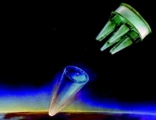 The Pentagon is considering acquiring up to four types of Reliable Replacement Warheads (RRW), twice as many as reported so far, according to an overview discovered by the Federation of the American Scientists on a Pentagon web site.
The Pentagon is considering acquiring up to four types of Reliable Replacement Warheads (RRW), twice as many as reported so far, according to an overview discovered by the Federation of the American Scientists on a Pentagon web site.
The Department of Energy told Congress in April that Los Alamos National Laboratory and Lawrence Livermore National Laboratory were working on “an RRW design” for completion later in 2006. The Washington Post added last month that a Senate subcommittee had added $10 million to next year’s budget to fund a design of a second RRW.
According to the new DOD overview, which looks beyond 2030, the future nuclear weapons stockpile would be made up of 4-6 different types of warheads (down from nine types today). A decision would be made mid-next decade about whether to have a mix of RRWs and existing warhead types or transition to an all RRW-stockpile.
In an apparent response to the Bush administration’s decision to reduce reliance of reserve warheads and instead transition to a “responsive infrastructure” that will produce warheads when needed, the DOD plan envisions “steady-state production of warheads for deployment” in the long term.
The plan also forecasts decisions on developments of warheads for the next generation of nuclear weapon delivery systems (missiles and aircraft).
The U.S. nuclear stockpile currently contains approximately 10,000 nuclear warheads of nine principle designs: B61, W62, W76, W78, W80, B83, W84, W87 and W88. The Bush administration has decided to reduce the total stockpile “almost in half” which is estimated to leave a stockpile of some 6,000 warheads in 2012.
While it is reasonable for governments to keep the most sensitive aspects of nuclear policies secret, the rights of their citizens to have access to general knowledge about these issues is equally valid so they may know about the consequences to themselves and their country.
Nearly one year after the Pentagon certified the Sentinel intercontinental ballistic missile program to continue after it incurred critical cost and schedule overruns, the new nuclear missile could once again be in trouble.
“The era of reductions in the number of nuclear weapons in the world, which had lasted since the end of the cold war, is coming to an end”
Without information, without factual information, you can’t act. You can’t relate to the world you live in. And so it’s super important for us to be able to monitor what’s happening around the world, analyze the material, and translate it into something that different audiences can understand.